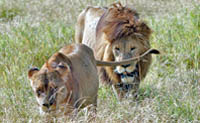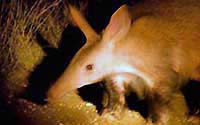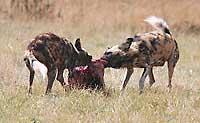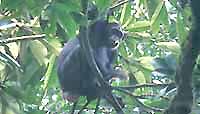# |
Species
[range] |
Photo/art [see credits]
all photos taken in wild unless stated |
Reason for choice |
DR seen? |
| 21 |
any Pangolin
family Manidae
Manis, Smutsia & Phataginus sp.
[Africa & s. Asia |
 |
Pangolins are strange
'artichoke-animals' of Africa & s. Asia that feed on ants and
termites. Some of the 8 species are terrestrial, others arboreal, and
all are solitary with a social life dominated by scent. It is
incredible lucky to come upon any of them. They are heavily hunted; Asian species [genus Manis] are now endangered. |
No |
22 |
Lion
Panthera leo
[Africa & s. India] |
|
The "King of Beasts" is the top predator of the African veld. It is so familiar and yet, upon encountering one in the wild, so very awe-inspiring. Numbers have been declining but it is still easy to see in African national parks and at in the Gir Forest of s. India. As the largest cat, is is often the most-sought-after mammal by first time travelers to Africa. It is everyone's "must see" African mammal. |
Yes |
23 |
Aardvark
Orycteropus afer
[Africa] |
|
Entirely nocturnal and rarely seen, Aardvark is so unique it is placed in its own Order, Tubulidentata. It feeds entirely on termites and ants, and digs burrows for sleeping during the day. Surprisingly large (size of German shepherd dog), it is exceedingly memorable when ones encounters it in the wild. |
Yes |
| 24 |
Dingiso Tree Kangaroo
Dendrolagus mbaiso
[c. New Guinea] |
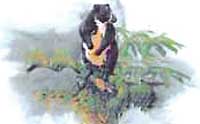 |
An elusive and endangered New Guinea endemic, its discovery by Tim Flannery in 1994 shocked the scientific world. The beautifully patterned marsupian lives in alpine forests of the Sudirman Range, Papua Prov., Indonesia. It is nearly impossible to see. It was not filmed until 2009, after 11 days' search with local Moni tribesmen. |
No |
| 25 |
Tasmanian Devil
Sarcophilus harrisii
[Tasmania] |
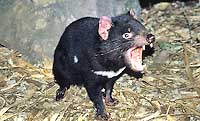 |
This fierce marsupial is the
largest carnivorous marsupial alive today. Although extirpated from
Australia long ago, it was common on Tasmania but is now threatened by an epidemic disease, and is much reduced. Said to be
pound-for-pound as vicious as any predator — and then it has a great
name — one of those iconoclastic beasts. |
No |
| 26 |
Pygmy Hippopotamus
Choeropsis liberiensis
[west Africa] |
 |
Very rare and local, most
remaining populations survive in Sierra Leone or
adjacent countries (Nigerian subspecies extinct). In behavior
it is more like a tapir than a hippo, spending much time inside the
forest but swimming often as well. It is primarily nocturnal; the few that I knew who've seen it used a night-scope for brief views, at best. |
No |
27 |
Bonobo
Pan paniscus
[c. Africa] |
 |
Also known as "pygmy chimpanzee,"
this is the forgotten great ape. It is restricted to rainforest south
of the Congo River in c. Democratic Rep. of Congo and, until recently,
almost entirely unknown. Now that some studies have occurred, we learn
that its social system is quite unlike the Chimpanzee that it generally
resembles. |
No |
28 |
African Wild Dog
Lycaon pictus
[e. & s. Africa] |
|
Sometimes called "Painted Wolf," this pack predator was once widespread. Habitat loss, hunting, and disease have reduced the extant population to a very few remote pockets, and it is now highly sought after on Africa safaris. The pack hunting techniques are very impressive. |
Yes |
29 |
Chimpanzee
Pan troglodytes
[c. Africa] |
|
Genetically our closest relatives, Chimpanzees are almost too well known from Hollywood or research. Yet wild chimps are often hard to find (but not so hard to hear) in the lowland forests of central Africa. They make sleeping nests but move sites daily. Their social system provides insights into our own ancestry. |
Yes |
30 |
Giant Anteater
Myrmecophaga tridactyla
[s. Central & South America] |
|
Although its range is broad, this unlikely combination of tail and snout is elusive and its numbers are relatively small, reaching highest densities in remote undisturbed pampas. It is the strangest beast in the New World. |
Yes |
|
Links to all of the "top 50"
RESOURCES & CREDITS
|
FURTHER READING:
This is not an exhaustive bibliography but rather personal choices of books, mostly in the popular literature genre, but all fact-based and well-written. I do not have favorite literature for all species, but for these see:
* For Lion: There are hundreds of books. So far I've most enjoyed the stories of lion research in Botswana in Mark & Delia Owens' (1984) Cry of the Kalahari: Seven Years in Africa's Last Great Wilderness [Mark Owens' project was on lions; Delia Owens was working on the elusive and little known Brown Hyena]. A good natural history is George Schaller's (1976) Serengeti Lion: a Study of Predator-Prey Relations, and I enjoyed Craig Packer's stories of working on the Serengeti lion project in Into Africa (1994).
* For Dingiso Tree Kangaroo: Tim Flannery's (1998) Throwim Way Leg: Tree-Kangaroos, Possums and Penis Gourds describes his field work as a mammalogist in both Papua New Guinea, and what used to be Iran Jaya (now Papua Province), Indonesia. Flannery is an entertaining writer and story-teller, and we learn not only about rare mammals in the mountains of New Guinea, but also the tribal culture that sometimes protects, and sometimes destroys, them. The formal description of this newly-discovered tree-kangaroo is in Flannery, T. F., Boeadi, and A. L. Szalay. (1995). "A new tree-kangaroo (Dendrolagus: Marsupialia) from Irian Jaya, Indonesia, with notes on ethnography and the evolution of tree-kangaroos." Mammalia 59:1 65-84.
* For Bonobo: Frans de Waal's (1997) Bonobo: the Forgotten Ape, illustrated lavishly
with Frans Lanting's photos, brought this species out of obscurity. It
turns out to be a fascinating ape with much open and promiscuous
sexuality by both sexes. Its social system lacks the male-dominated
hierarchy so typical of aggressive Chimpanzees. From a human
perspective, it is almost like looking at an alternative approach to
our own origins....
* For Chimpanzee: Obviously, the popular works are Jane Goodall's (1967) My Friends the Wild Chimpanzees and her (1996) My Life with the Chimpanzees, both accounts of her field work, and then her more formal natural history in the (1980) The Chimpanzees of Gombe: Patterns of Behavior. I also enjoyed Craig Packer's (1994) stories of working with her at Gombe in Into Africa.
* For African Wild Dog [Painted Wolf], several good stories are in Mark & Delia Owens' (1984) Cry of the Kalahari: Seven Years in Africa's Last Great Wilderness.
CREDITS:
All artworks are copyrighted by the artist (as detailed below) and are either used with permission or are posted here in reliance on the non-commercial "fair use" doctrine; all rights are reserved by the artist
* Peter Schouton painted Dingiso Tree Kangaroo (from Flannery, Martin
& Szalay's 1996 Tree Kangaroos: A Curious Natural History)
* Helmut Diller painted Bonobo (from
Haltenorth & Diller's 1980 Field Guide to the Mammals of
Africa including Madagascar)
All the photographs are copyrighted by the photographer (as detailed below) and are used with permission; all rights are reserved to the photographer
* Rita Carratello photographed Aardvark (South Africa; this is a video capture)
* Don Roberson photographed Lion (Tanzania), Chimpanzee (Uganda), and Giant Anteater (Brazil)
* Babette Alfieri of Kuyenda Bushcamp photographed Ground Pangolin Manis
temmincki (South Luanga NP, Zambia)
* African Wild Dog photo is from Wikipedia (unattributed)
|
TOP
Page created 1-6 June 2002, updated 20 Aug 2002, revised 29 Aug 2010, 18 Feb 2021 & 24 Oct 2021 |
|

